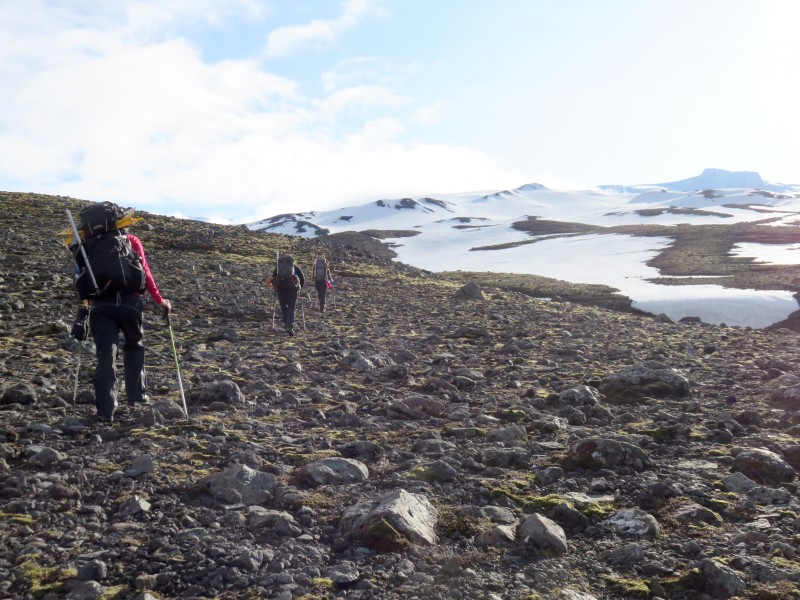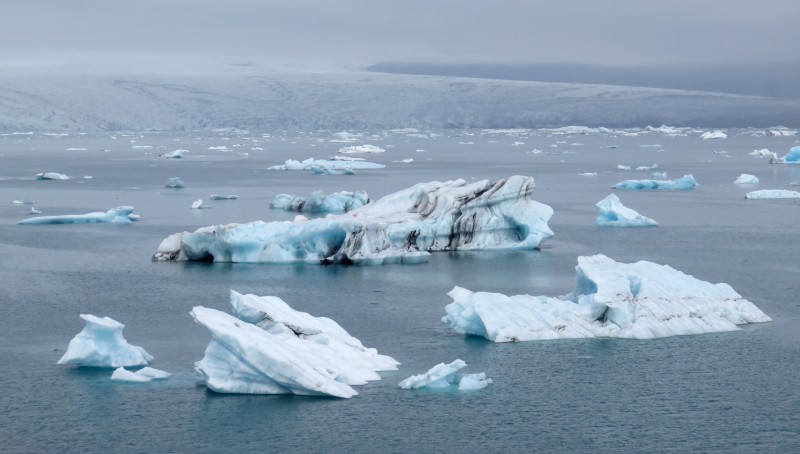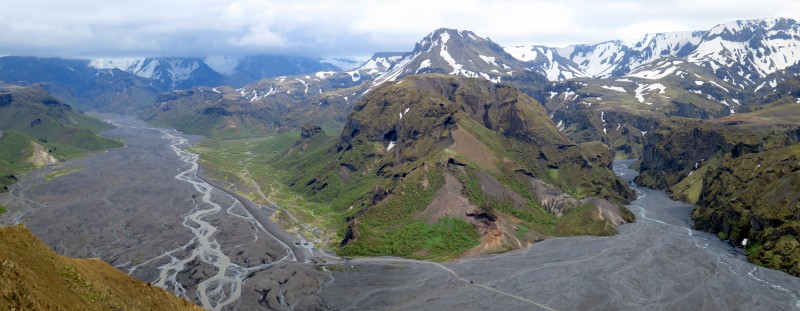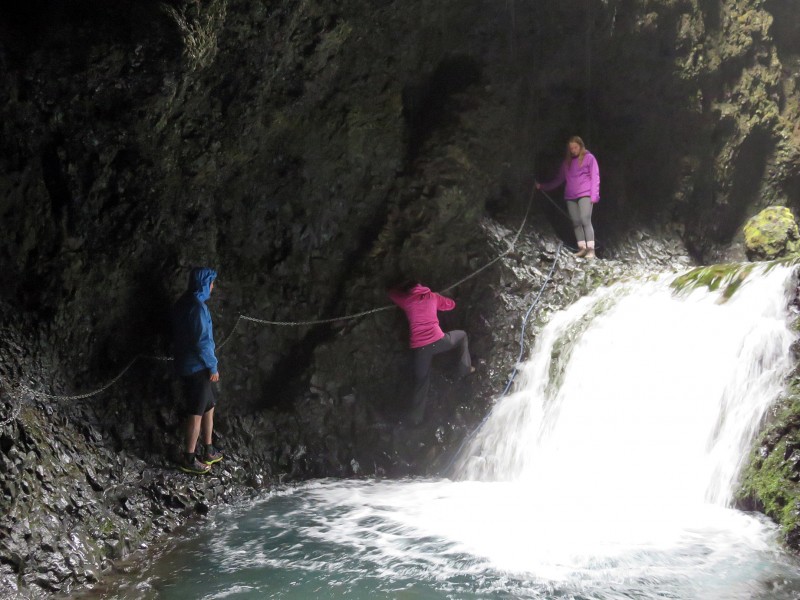| Report Type | Full |
| Peak(s) |
Hvannadalshnukur - 6923 |
| Date Posted | 07/22/2015 |
| Date Climbed | 06/18/2015 |
| Author | Aubrey |
| Hvannadalshnukur, Iceland's Highpoint |
|---|
|
Our summit day didn't start out so well. My wife Jen and I gave ourselves two days to adjust to the 7-hour time change (we flew to Reykjavik on a 7-hour flight from Vancouver, B.C., which is just an hour north of our home in Bellingham, WA), and we gave ourselves 8 hours to sleep, but neither of us were able to sleep for even a minute the entire night. Sometime around 3 in the morning, I was just like, "Eff it, let's just get up." I was tired, grumpy and not looking forward to breakfast, which consisted of peanut butter and jelly sandwiches. We have both climbed countless mountains on very little sleep, especially the ones requiring alpine starts, but neither of us have attempted a big mountain without any sleep at all. At least the weather looked decent. It was much better than the forecast, and tremendously better than the previous two rainy days. From our hotel room window, Hvannadalshnúkur (pronounced kvah-nuh-doll-shnooker, more or less) stretched for miles across the horizon.  Other hotel views:  On the previous day, we met our guide, Védís (pronounced like "Vietnamese," but without the "nam") of Icelandic Mountain Guides (IMG), and she briefed us about the climb. Even though Hvannadalshnúkur is not a technically difficult mountain, we decided to go guided for two reasons. First, we knew the local guides would have an intimate knowledge of the not-so-straightforward route, plus they would know the current snow and crevasse conditions, not to mention the local weather patterns. Second, we needed at least one other person for the roped portion of the climb. The downside of going guided, however, is that your summit chances are dependent on the other people on your team. If one person can't go on, everyone has to go back down. At 5 a.m. we met Védís and the rest of our team - a guy from North Carolina and a guy from Scotland. Another couple backed out the day before after learning about the grueling details of the climb. Another IMG guide reported abnormally soft snow, and he recommended that we bring snowshoes. I hate postholing, but I hate snowshoes even more, so I wasn't happy. Whether they're on my back or my feet, I knew the added weight would add an immense amount of difficulty to the 14-mile round trip. Being mid-June in Iceland, and at a latitude equal to Fairbanks, Alaska, it never got dark. It was kind of nice not having to deal with headlamps. With heavy packs holding all sorts of winter gear, we started up the rocky trail. It didn't waste any time gaining elevation.  Hvannadalshnúkur only reaches 6,923 feet (2,110 meters) into the sky, but the trailhead is not far above sea level, so you pretty much have to climb the entire mountain.  Maybe a thousand feet or so up, there was a small stream that was our last opportunity to fill our bottles. They say water is so pure in Iceland that you can drink it right out of streams without filtering or purifying. I saw many people doing it, but I just couldn't bring myself to do it. I just kept thinking of all the sheep I saw on hillsides throughout the country, not to mention all the pooping birds.     Crazy enough, we ran into a friend of ours from Canada, who was climbing the mountain with another group. People from both groups couldn't believe we just happened to run into each other on the mountain. Neither could we, as we didn't think our schedules would jive. But he ended up climbing Hvannadalshnukur instead of trekking in Landmannalaugar because late-season snow blocked access to his route, so he had to switch plans at the last minute. But that's another story. Roughly a few thousand feet above sea level, we reached the snow line. The angle of the slope was gentle, but it was relentless. The sea of white was only broken by patches of black lava rock. I kept expecting to see Jon Snow and some Wildlings.  As we climbed, the snow became deeper and softer, and it had a consistency somewhere between a snow cone and a Slurpee. In other words, it sucked. When we hit the toe of the glacier, we roped up and donned our snowshoes. I was glad to have the weight off my back, but then my feet began to suffer. With each step, slushy snow accumulated on the tops of my snowshoes, adding even more weight to lug up the mountain.  On the positive side, the weather appeared to be holding, the scenery was incredible, I was feeling pretty good, and I finally got my stepping and breathing into a delightful alignment.  But my groove kept being disrupted because one of the guys on our team had to stop repeatedly to take breaks. Clearly, he was beginning to show signs of fatigue, and his fast pace at the beginning of the hike seemed to be catching up with him. This was the first time I became concerned that we might not make it to the top. Pain and suffering for long periods of time is actually a big part of mountain climbing. Non-climbers never understand this. New climbers either accept it and eventually become old climbers, or they just quit climbing big mountains. I like to remind myself that the pain is temporary, but the memories last a lifetime. Plus, in a sick and twisted sort of way, it feels kind of good to kick your butt to the extreme every once and a while.  I'm not going to sugarcoat things, though, this was an exhausting climb. Beyond the long distance, the major elevation gain and the challenging snow conditions, temperatures continued to swing wildly from brutally hot to freezing cold.  When we finally reached the base of the last pitch to the summit, we swapped our trekking poles and snowshoes for ice axes and crampons. This was when our pace slowed to a crawl, as that same climber had to stop often to catch his breath. I thought our climb was over, just hundreds of feet from the top. Fortunately, he continued to move, albeit in slow motion.    When we started up that last pitch, the summit was sunny. But the higher we climbed, the cloudier it became. Then, within a matter of minutes, visibility became severely reduced and the temperature seemed to drop 40 degrees. From my position in the back of the rope team, I heard the guy (who was having trouble) blurt something out. When I looked up, I noticed he had fallen into a crevasse up to his waist. I anchored my axe while he tried to pry his leg out. After a couple minutes, Védís ended up having to climb back and dig him out with a shovel. Védís was a great guide, BTW. I liked her scrappy toughness and pragmatic attitude.    After about seven hours of slogging - with multiple breaks - we finally reached the top of Iceland. A cloud obscured our views, but I was just happy to have made it, and this was no time to be greedy.  The icy peak known as Hvannadalshnúkur actually sits on the northwest crater rim of Öræfajökull, Iceland's largest active volcano. Even though Öræfajökull is a seriously massive mountain, it is only a small part of Vatnajökull, which is the largest glacial ice cap in Europe by volume (it averages 1,300 feet thick) and the second-largest ice cap in Europe by area (with 3,100 square miles). Vatnajökull is so large that it takes up 12 percent of Iceland's surface area. That endless ice cap would have been a nice sight to see, but again, I felt lucky just to have made it to the top. With the weather rapidly turning for the worse, we didn't spend much time on top. On our descent, Védís told us that Öræfajökull's 1362 eruption was the most violent and explosive volcanic eruption in Iceland's recorded history. This gave my sleep-deprived mind something to ruminate on during our long, five-hour descent. At one point, we experienced near whiteout conditions, and the blowing snow was hypnotizing. But then I'd hear a thunderous crack from the nearby icefall area, and my mind would jolt back to reality once again. At times, it was difficult to tell where the snow ended and the sky began.  The rest of the descent was agonizingly endless, but at least the weather improved.  But then it improved too much. By the time we made it back down to the trailhead, I was sweating profusely in a t-shirt. Normally, post-climb, I crave beer and food (in that order). But all I could think about was sleeping. Back at our hotel, Jen and I still managed to force down some fish & chips and a couple beers, but then we crashed hard. It was the best night of sleep I've had in a long time. ### Iceland was one of the most scenic countries I have ever visited. During the two weeks we spent there, we did many other hikes, tours, etc., so I thought I'd share some random pics that I took. FYI, if you're considering a visit to Iceland, I know there's a direct flight from Denver because we met a mother and daughter from Boulder that told us about it. It's an expensive trip, but at least it's convenient. And IMO it's worth every dollar.                   |
| Comments or Questions | |||||||||||||||
|---|---|---|---|---|---|---|---|---|---|---|---|---|---|---|---|
|
Caution: The information contained in this report may not be accurate and should not be the only resource used in preparation for your climb. Failure to have the necessary experience, physical conditioning, supplies or equipment can result in injury or death. 14ers.com and the author(s) of this report provide no warranties, either express or implied, that the information provided is accurate or reliable. By using the information provided, you agree to indemnify and hold harmless 14ers.com and the report author(s) with respect to any claims and demands against them, including any attorney fees and expenses. Please read the 14ers.com Safety and Disclaimer pages for more information.
Please respect private property: 14ers.com supports the rights of private landowners to determine how and by whom their land will be used. In Colorado, it is your responsibility to determine if land is private and to obtain the appropriate permission before entering the property.
